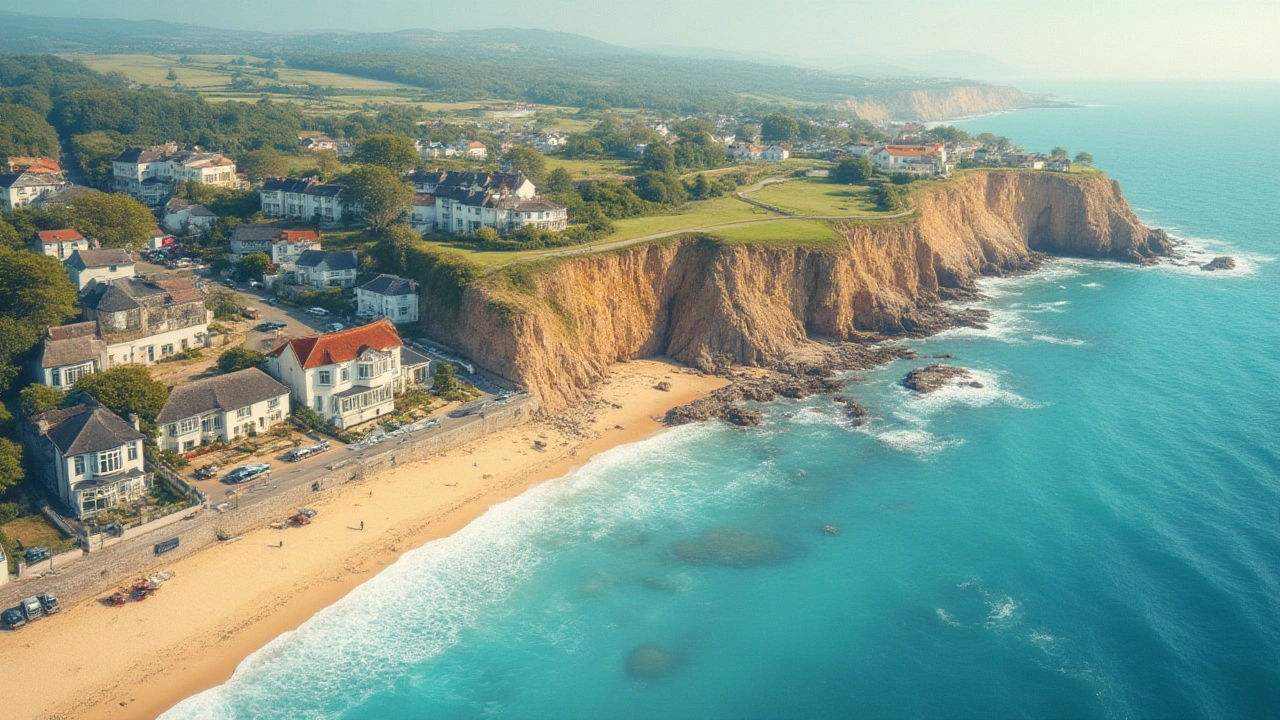Imagine waking up to the sound of waves rolling in, the salty air filling your lungs, and sunlight reflecting off endless blue. For many, owning a slice of the coast is a life goal. But here’s the catch: when you start the search for that dream place, you’ll see two words over and over—beachfront and oceanfront. They get thrown around like they're the same thing. Realtors do it. Listings do it. But confusing these terms can mean setting your hopes on a home that doesn’t fit your vision—even paying thousands more for features you didn’t want. People fuss over whether their window faces a pool or garden, so shouldn’t you know exactly what you’re buying when it comes to the sea?
The True Meaning of Beachfront and Oceanfront
Okay, here’s where the rubber meets the sand. The difference between beachfront and oceanfront property isn’t just marketing fluff—it makes a real difference in what you see, what you can do, and how you live. Beachfront means you step out your door (or maybe climb down a few steps), and your toes hit the sand. Think of those postcards with cottages nestled right on a dune, maybe a hammock strung between two palms and not a single soul between you and the surf. If you want to walk just a few feet from your porch to the water for an early swim or evening stroll, beachfront property is what you want. It’s direct access. Instant gratification. No shoes required.
Now, oceanfront is a little trickier. The phrase sounds just as exclusive, but it’s sneakier. Oceanfront simply means the property faces the ocean—nothing in the definition says there will be sand outside, or even that you can reach the water without breaking out your climbing shoes. Some oceanfront homes sit perched on rocky bluffs with amazing views, but no shore access unless you take a hike. Others come up right to a seawall, or overlook pebbles, reeds, tide pools, or even marshland. If standing on your balcony watching waves crash onto rocks is enough, oceanfront could be perfect. But if you’re picturing sandcastles, you’ll need to read the fine print.
Real estate agents sometimes play it loose with these labels, especially online. I’ve seen homes called 'beachfront' that sit across a road and parking lot from actual sand. Some 'oceanfront' listings look spectacular in photos but offer no safe way to dip more than your toes. And let’s not even mention the wild-card 'waterfront'—that could mean a salt marsh, a storm-battered bulkhead, or in some regions, even a pond. No wonder buyers get tripped up!
Coastal property guides say that in high-demand regions—like parts of Florida’s Gulf Coast or California’s Orange County—buyers pay up to 30% more for verified, legal beachfront. In much of New England or the Pacific Northwest, oceanfront bluffs are considered more private, quieter, and sometimes even more expensive than sandy stretches jammed with vacationers.
There are even legal definitions, depending on local governments. For example, in some U.S. towns, only land that includes legal, private access to a swimmable beach can be marketed as 'beachfront.' In Australia, 'absolute beachfront' is a protected term and using it incorrectly could lead to fines. Check out your target area’s zoning laws, because taking an agent’s wording at face value can land you in hot water. Thanks, bureaucracy!

How Location Shapes Your Experience (and Your Wallet)
Not all coastlines are created equal, and the price you’ll pay for that address tag—either beachfront or oceanfront—has everything to do with what the shoreline really is. If you want to make the smart move, it’s time to dig past the buzzwords (and probably dig into your savings account too).
Let’s break down how physical geography affects these terms. If you head to Cape Cod, for instance, some 'oceanfront' homes cling to cliffs so steep, getting to the beach is an adventure requiring hiking gear and possibly a rope. In the Outer Banks of North Carolina, beachfront homes are built directly on sand that changes shape every storm. In Maui, true beachfront often means a thin ribbon of property, just a few feet separating your lanai from crashing surf. And in the Pacific Northwest, many majestic properties boast oceanfront views, but dips to the shore (if possible) involve a scramble down rocky, tree-shaded inclines. Here’s how that can look at a glance:
| Region | Beachfront Definition | Oceanfront Definition | Typical Price Premium |
|---|---|---|---|
| Florida (e.g., Naples) | Direct access to sandy beach | Faces ocean, may be rocky/bluff/seawall | Beachfront up to 30%+ over oceanfront |
| Pacific Northwest | Rare, limited stretches of sand | Cliff or rocky shoreline, dramatic views | Oceanfront sometimes pricier than rare beachfront |
| Australia (Gold Coast) | 'Absolute beachfront,' direct sand contact | May mean only water view or access blocked | Beachfront 20-40% higher per square meter |
| Mediterranean (e.g., Greece) | Sandy, private, swimmable shore | Rocky, terraced, or cliff-side | Beachfront often double oceanfront price |
But it’s not just a money story. One major lifestyle difference: privacy. Beachfront homes often draw foot traffic, especially if the beach is public access. Be ready for kids shrieking, lovers picnicking, and paddleboarders gliding past your deck. Oceanfront on a bluff? Probably less sound, fewer people, just seagulls for company—but also a trickier path down for a swim. There are always tradeoffs.
Flood risk is another deal-breaker for some. Beachfront tends to bear the brunt of coastal storms and erosion. Hurricane-prone areas now require crazy-high insurance premiums or even special building codes—think raised pilings or hurricane-proof glass. Oceanfront properties, set on natural rises or cliffs, can dodge the worst surge, but cliff erosion is a headache of its own. If you plan to Airbnb, know that beachfront fetches higher nightly rates—but also brings stricter insurance demands and more competition from hotels and resorts.
And then there’s the emotional wow-factor. Even non-swimmers fall in love with sound, scent, and an unobstructed sea horizon. Buyers often pay a premium to trade city bustle for peaceful waves, which helps explain why both styles of property continue to climb in value. The luxury market knows that direct sand-on-toes access is still unmatched for families, retirees, and people who just want to brag on Instagram.

Buying Smart: What to Watch For, and Bonus Tips
So, you’ve decided ocean access is non-negotiable. Here’s how to make sure you get what you want and don’t get burned. First, insist on a walk-through, and don’t be shy—get outside, look at the lot lines, stand at every window. Even if the listing shows 'private beach,' confirm if it’s shared by a whole row of neighbors or open to the public. And since legal access varies wildly, ask for documentation. Some hot spots (like Malibu or Fort Lauderdale) see frequent lawsuits over who can cross what to reach the sand. If you dream of hosting bonfires or sunrise yoga, you want to know exactly where your property ends and public land begins.
Instead of fixating just on the view, check up on what you can do—are barbecues allowed on your slice of sand? Can you dock a kayak or set up a volleyball net? In some towns, all sorts of rules govern everything from fence height to sand dune restoration. It’s not rare to buy a slice of heaven, then learn you can’t build a deck or put up a privacy hedge.
If peace and quiet matter, consider your neighbors. In resort towns especially, beachfront properties can be surrounded by short-term rentals, which means new faces every week (and sometimes party noise for days). If you crave tranquility, oceanfront spots with only a handful of homes nearby might be a better pick.
Resale value is real, especially if you’re investing for the long term. Historically, true beachfront properties weather market downturns better than almost any other segment, simply because natural coastline can’t be created. According to a 2024 National Association of Realtors study, U.S. beachfront homes outpaced national appreciation rates by nearly 12% over a four-year span, especially those with legal, walk-out access.
Maintenance is where the tide can really turn. On sandy lots, salt air and moisture can shorten the lifespan of everything—roofs, siding, decks, paint, even your Wi-Fi router. Plan for annual touch-ups and be ready to shell out more on weather-resistant materials. Seawall repairs and dune restoration can run into the tens of thousands every few years. Insurance? That’s another story. In flood-prone zones, some carriers will only cover you if you go through specialized high-risk pools, which cost a fortune.
- Always check local erosion rates. Beaches can vanish a lot faster than you think. Some properties that were prime beachfront twenty years ago now sit a stone’s throw from a riverbank, or worse, have lost their walkways entirely due to storms and rising tides.
- If you plan to work remotely or run a digital business while gazing at the ocean, double check cell signals and internet speeds. Some coastal towns are notorious for slow connections and frequent outages.
- Don’t fall for photo tricks. Agents often use drone shots to make properties look closer to the water, or conveniently crop out highway barriers, public walkways, or neighboring high-rises. Google Satellite View is your friend—spend some time with it before you book any flights.
- Visit at high and low tide if you can. Some ‘perfect beaches’ disappear for half the day, leaving only slippery rocks or puddles behind.
- If you're concerned about climate change, check local and federal floodplain maps. FEMA updates these regularly in the United States, and they're crucial for insurability and mortgage approvals.
Of course, there’s no substitute for trusting yourself. If sandy toes every morning and sunset strolls are your vibe, nothing else will do except a true beachfront. If you care more about soaking in a wide, wild vista and don’t mind a few steps (or a slope) between you and the ocean, oceanfront could be your sweet spot. Either way, don’t settle for anything until you’ve stood on the spot yourself at least once—what sells in a listing might not spark joy when you’re the one writing the mortgage checks. The sea will always call to you, but the best investment is one that fits how you really want to live. Happy hunting.
